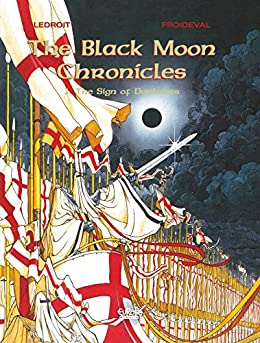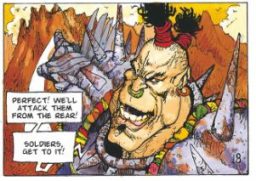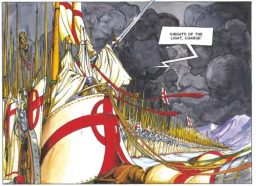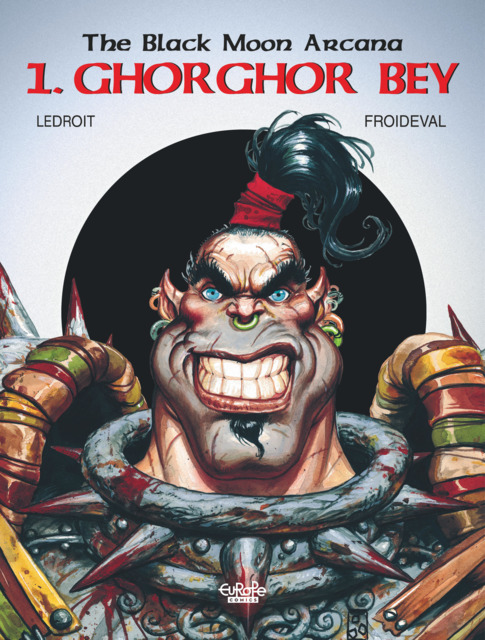 God might not play dice with the universe, but the devils do.
God might not play dice with the universe, but the devils do.
In The Black Moon Chronicles: The Sign of Darkness, written by François Marcela-Froideval and drawn by Olivier Ledroit, Lucifer grows tired of his generals throwing matches in their little games. So he engineers a game in the mortal world where none of the players can deliberately lose. A Chosen One prophecy and the fall of an empire would do nicely. But what man will be chosen?
He might be a nameless lancer out in the woods, little more than a highwayman in armor. Call him Wismerhill after his home town, or Wis for short. It’s as good a name as any. But this half elf has an unknown past and hints of more sinister gifts, as the rogue Heads-or-Tails discovers in their first meeting. Wis may be sheltered and naive, but he falls into bad company with the mercurial rogue, whose personality shifts based on which of two magical swords, good or evil, he currently wields. The two fast friends embark on a series of petty crimes and capers. But the eye of the half-ogre Gorghor Bey soon settles upon Heads-or-Tails’ swords.
The swords, however, are attached to Heads-or-Tails, and it is only by the whim of Gorghor Bey that the two highwaymen keep their heads. Now fighters for the half ogre warlord, Wismerhill and Heads-or-Tails join the Gorghor Bey’s invasion of the Empire. Caught up in a whirlwind of fighting, training, and loving, Wis quickly distinguishes himself as a valued aide, able to read the winds and save the horde from multiple ambushes as they raze the hinterlands of the Empire. But such a display of military power cannot go unchecked, so the Empire sends the Army of Light after Gorghor Bey. And other, more sinister forces have taken notice of the chaos for their own ends.
 The Sign of Darkness serves as the ever-popular origin story for the twenty volume Black Moon Chronicles. This French dark fantasy series has given birth to two spin-off series and even a video game. The emphasis here is on dark fantasy, if the slight elven warrior with an evil magical sword was not a clue. Wis is fighting on the side of orcs, ogres, and barbarians against the setting’s version of Gondor, and there is no mistaking these invaders for the side of Good. At best, Wis and his companions act as anti-heroes who are a little too comfortable with the terrible acts they commit. But those acts are in the future. The Sign of Darkness is comics’ answer to The 36th Chamber of Shaolin, an extending training montage pushing Wis from a nameless tough to a champion on the run. He has yet to be swept up into the various gambits playing out for control over the Empire.
The Sign of Darkness serves as the ever-popular origin story for the twenty volume Black Moon Chronicles. This French dark fantasy series has given birth to two spin-off series and even a video game. The emphasis here is on dark fantasy, if the slight elven warrior with an evil magical sword was not a clue. Wis is fighting on the side of orcs, ogres, and barbarians against the setting’s version of Gondor, and there is no mistaking these invaders for the side of Good. At best, Wis and his companions act as anti-heroes who are a little too comfortable with the terrible acts they commit. But those acts are in the future. The Sign of Darkness is comics’ answer to The 36th Chamber of Shaolin, an extending training montage pushing Wis from a nameless tough to a champion on the run. He has yet to be swept up into the various gambits playing out for control over the Empire.
The setting is familiar, with a gleaming white Empire as the bastion of church and civilization standing against a tide of invading barbarism. This time, we see it from the invaders’ point of view, without the expected propaganda of imperial hypocrisies that a contemporary version of the story would demand. Some people just want to watch the world burn. Those willing to light the match fight for Gorghor Bey. The resulting chaotic, orkish invasion is so familiar, as are Wis’s winds of magic, that it would not be a surprise to discover that Games Workshop plundered the Black Moon Chronicles as they did The Lord of the Rings for their Warhammer Fantasy setting. As of yet, the Black Moon Chronicles does not revel in the destruction and cruelty to the same degree that a grim dark world where there is only war has, or with the exquisite artistry of a Melniboné. Instead, a strong dose of self-deprecating humor keeps the excesses away.
 The Black Moon Chronicles uses an interesting design choice. Those characters and objects which are evil, or, in the case of Wis’s powers, chaotic, have rougher, dingier, uglier art. Clean lines and beauty are reserved for the good, whether that be the Army of Light or Feidreiva, Wis’s unlikely lover who spends less time clothed than French fanservice favorite Laureline. And as Gorghor Bey changes from Wis’s captor to mentor, his portrait smooths. But the real star of the artistic show are the big battle set pieces. Ledroit conveys in his art both the immense scale of massive armies as well as the immense chaos of battle. The only portrayal that comes close is The Return of the King‘s field battles.
The Black Moon Chronicles uses an interesting design choice. Those characters and objects which are evil, or, in the case of Wis’s powers, chaotic, have rougher, dingier, uglier art. Clean lines and beauty are reserved for the good, whether that be the Army of Light or Feidreiva, Wis’s unlikely lover who spends less time clothed than French fanservice favorite Laureline. And as Gorghor Bey changes from Wis’s captor to mentor, his portrait smooths. But the real star of the artistic show are the big battle set pieces. Ledroit conveys in his art both the immense scale of massive armies as well as the immense chaos of battle. The only portrayal that comes close is The Return of the King‘s field battles.
I am intrigued by the potential in The Black Moon Chronicles: The Sign of Darkness. It is just the opening act, and the villains and main conflict of the story have yet to be revealed. Fortunately, the full 20 volume series is offered on Kindle Unlimited, making it easy and affordable to follow along Wismerhill’s journey under the Black Moon.
 Of all the terrifying warlords to wreak destruction across the empire, few can match the savagery of Ghorghor Bey. His name alone can cause even the bravest of soldiers to tremble in their boots, and noble lords and ladies throughout the land pray that he never comes knocking at their castle doors in search of gold, booze, and maidens. But few know the tragic story behind this fearsome warrior’s rise to power. From his harrowing childhood to his first love(s), his devastating heartbreaks and crushing victories, read on and discover how a naïve young half-ogre would go on to become Ghorghor the Terrible.
Of all the terrifying warlords to wreak destruction across the empire, few can match the savagery of Ghorghor Bey. His name alone can cause even the bravest of soldiers to tremble in their boots, and noble lords and ladies throughout the land pray that he never comes knocking at their castle doors in search of gold, booze, and maidens. But few know the tragic story behind this fearsome warrior’s rise to power. From his harrowing childhood to his first love(s), his devastating heartbreaks and crushing victories, read on and discover how a naïve young half-ogre would go on to become Ghorghor the Terrible.
I’ve been rather taken with the Black Moon Chronicles, the French dark fantasy comic from François Marcela-Froideval, Olivier Ledroit, and Cyril Pontet that uses humor to soften the horrors of a decadent Melniboné-style empire falling to the apocalypse. At turns aiding and resisting the fall into soul-devouring horror is the half-elf Wismerhill, the unwitting pawn of the evil Black Moon. But how did fate draw Wismerhill’s companions to him? And who better to start with than the jovial giant, the fearsome half-ogre warlord now know as Ghorghor Bey?
The first of The Black Moon Arcana serves as a direct prequel to The Black Moon Chronicles: The Sign of Darkness, detailing the rise of Ghorghor Bey from outcast to the scourge of the Empire as he is in the days before he meets Wismerhill. While the prequel sheds little new light into the twists and turns of the Black Moon’s world-dooming invasion or Ghorghor’s revolving-door relationship with death, it is a welcome insight into a beloved character who tends to get only a panel to two to mug in each new volume.
However, this prequel checks the boxes on the standard villain’s back story. Stop me if you’ve heard this before. A half-ogre child born from rape and unwanted pregnancy cruelly shunned by his adopted father and the rest of the village. When his mother dies, the half-ogre is expelled from the village and forced to live on his own–
Yes, I thought so too.
The boy, Ogur, falls in with the circus, where he finds acceptance and love among the freaks and performers. He learns the strongman routine and finds the loves of his life in a pair of Siamese twins. Here, he has the family he was denied.
Until a lord double-crosses the circus. The lord enslaves most of the circus, and drives Ogur and the rest of the freaks into the swamp. While there, a Divorak swamp kraken attacks, devouring Ogur’s loves. Ogur slays the monster, and swears a blood oath to avenge his friends and lovers. And when he slays the leader of a band of highwaymen, Ogur has the opportunity he has sought, as the highwaymen give him their allegiance. Now calling himself Ghorghor Bey, the half-ogre raises his standards, and rogues, orcs, and ogres rally to him. The new warlord scourges the local nobles, returning the brutality that the lords had visited upon him. Yet he never loses the whimsy that surrounds him, a brutal whimsy that never turns to cruelty. You may die in Ghorghor’s jests, but you will not die slow.
Finally, the warlord returns to the lands of the lord who wronged him. Ghorghor Bey single-handedly breaches the castle and, one by one, pitches the defenders over the walls. No quarter will be given until he frees his friends. After the lord is slain and the chains on the circus performers broken, Ghorghor Bey turns his fury against the nobility, scourging the Empire in the first of many apocalyptic invasions that will tear it apart. And, along the way, he runs into two bandits, the mad elf Heads-or-Tails and magic-touched Wismerhill…
As I said, standard villainy fare. But the Black Moon Chronicles tries to make a distinction between being bad and being evil, between falling and fallen. Ghorghor Bey is undoubtedly bad, driven to his own cruelty by the cruelty of others, but he never crosses into the demonically evil. That terror is saved for Wismerhill. And for unrepentant, soul-devouring evil? Wait until we meet Haazel Thorn.
There is a rough honor to the brutal and cunning Ghorghor Bey, who later becomes Wismerhill’s trusted lieutenant. There’s also the bit of the clown, of intelligence, whimsy, and the subversion of expectations, including a surprising gentleness. The performer never left the warlord, as he can be found mugging in the background of many a panel. But the one thing he is not is the dullard brute that many ogres are portrayed as in fantasy. That Ghorghor Bey is given a chance to shine once more outside Wismerhill’s shadow is welcome. I just wish there was more meat to these formulaic old bones.
So, at the start, The Black Moon Arcana is for the fans already invested in the signs and portents of the Black Moon. But maybe when we get to the true holy knight Parsifal, the story will pick up. In the meantime, please check out the more palatable Elric-type story that is the Black Moon Chronicles.

Please give us your valuable comment